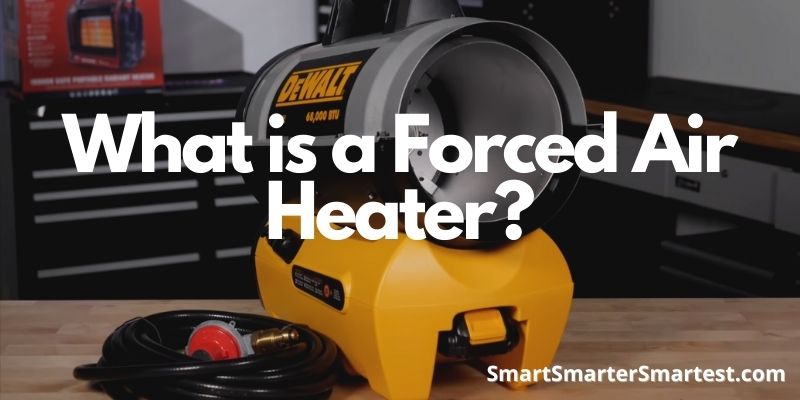Just like you may be wondering yourself, many people have only heard the term forced air heating and know it has to do with household heating systems, but do not actually know what it means. It may seem confusing to understand at first, because of all the different kind of heating systems available.

A forced air heating system uses air to carry heat distributes air across your house evenly. To keep the desired temperature around the house, he hot air goes first through a mechanism of ducts before it is expelled in ventilation through your home. You have the possibility to choose what temperature to set the thermostat. The heat will only actively flow when the temperature is below the desired one.
There are different materials forced air systems can be made of. Electric furnaces, gas furnaces, hydronic coils, and heat pumps are examples of what can be used to heat air. Once a fan or blower is attached to one these mechanisms it can evenly heat your house.
Forced air heating systems can not only maintain heat for your home through all of winter, but it also saves on energy compared to other heating systems. The centralization of the forced air heating system makes it capable of regulating the household temperature all year. For the system to not only heat your household but cool it was well, heat pumps are ideal.
If ductwork is already installed in your house, it makes sense to have a forced heating air system installed. This is also the case if you are building a house and considering different heating options. That said, it can be very expensive to have a forced heating system installed in a house which is not equipped with ductwork.
The Positive and the Negative of Forced Air Heating
Forced air heating is the best compromise between affordability and effectivity. it takes very little time for the system to heat up a house.
Time
The system heats up households faster than any other heating mechanism. Unlike other heating systems, water does not have to be heated, and its fast distribution through ducts gives it precise and quick results.
Installation
It is easy and hassle-free to install this forced air heating system, unlike the construction something like a radiator may necessitate.
Inexpensive
Forced air heating, as noted before, is inexpensive compared to other heating systems such as radiant heaters. It is a great price considering the quick and effective results from the system.
Reliable
Due to the solidity of ducts, they are more reliable and will last longer than a system which uses a pump, for example. This reliability can relieve any stress of the system breaking or failing you in the middle of winter. It is another reason to choose the forced air heating system rather than other heating systems.
The Negative
As your consider purchasing a forced air heating system, it is important to weight the negative aspects of the product alongside the positive.
Health risk
Dust particles, mold, and harmful particles could be carried throughout you house as the air travels. It is important to make sure the ventilation and heating system are regularly cleaned to prevent mold from developing or dust to accumulate.
Noise
Heating systems always make noise, and it is difficult to reduce it.
Just as any other heating system, the forced air one makes noise which cannot be 100% prevented.
Central Temperature Control
While air travels through the entire house, there may be some difference in particular room temperatures as only one thermostat is used to measure the heat.
Depending on where each room is located and how the ductwork is set up, it may receive more or less warm air which determines its temperature. Individual thermostats for rooms are rare.
Leaky Ductwork
Just as with any equipment, it is always possible for something to become faulty. With ductwork, it is possible for leaking to develop. This happens if the system is of low-quality and will over-time lessen in quality.
To recognize a possible faulty ductwork, check on your electricity bill frequently, as a sudden increase is a possible sign. If you are also noticing a change in the heat distribution or strength around the house, this may be a sign as well.
Tips
Filter maintenance
Filters keep the air clean by catching dust and particles. It helps reduce allergies and the toxicity of indoor air, which is much less clean than outdoors. We recommend you replace your filter every three months in order to ensure your air is clean, and that the system is working properly.
Professional Check
It is important to have a professional verify the system before turning it on for the first time or turning it off for the season. If they see the system is malfunctioning, they will be able to identify it and fix any problems there may be. Make sure to book your appointment early so you do not have any unexpected expenses during the season.
Check Your Ductwork
Along with checking your filters regularly, make sure you are looking at your ductwork as well. They must be damage-free to properly function. Kinks in the metal can impede air flow in the ventilation. Making sure any necessary repairs are done is important for warm air to properly warm to house all season long.
Thermostat
Programmable thermostats are the best thermostats for any household. They allow you to program different temperatures at different times of the day, different days a week. This is great for saving energy and money if there are days when you are out at work and no one is home.
Old thermostats can be harder to regulate, and you must remember to turn on and off the heater and changing the temperature can be a hassle. Programmable thermostats are the optimal choice for any homeowner. It should be check by a professional to ensure it is properly installed and working, as with the sensors.